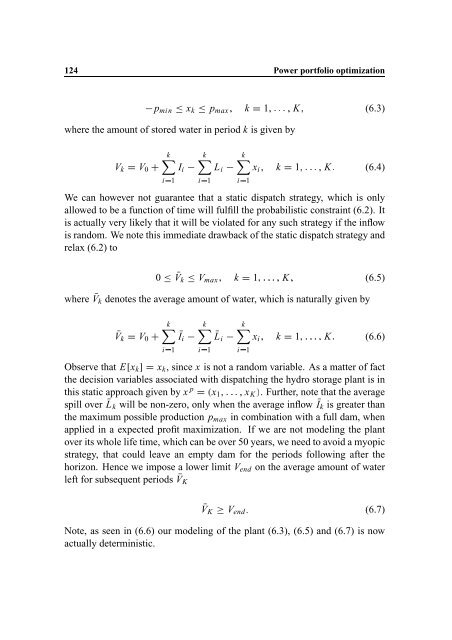Hedging Strategy and Electricity Contract Engineering - IFOR
Hedging Strategy and Electricity Contract Engineering - IFOR
Hedging Strategy and Electricity Contract Engineering - IFOR
Create successful ePaper yourself
Turn your PDF publications into a flip-book with our unique Google optimized e-Paper software.
124 Power portfolio optimization<br />
p min x k p max k 1Ü Ü Ü K Ü (6.3)<br />
á@á?á<br />
where the amount of stored water in period k is given by<br />
V k V 0<br />
k<br />
I i<br />
k<br />
L i<br />
k<br />
iâ 1<br />
iâ 1<br />
iâ 1<br />
x i Ü k 1Ü<br />
Ü K á<br />
(6.4)<br />
á?á@á<br />
We can however not guarantee that a static dispatch strategy, which is only<br />
allowed to be a function of time will fulfill the probabilistic constraint (6.2). It<br />
is actually very likely that it will be violated for any such strategy if the inflow<br />
is r<strong>and</strong>om. We note this immediate drawback of the static dispatch strategy <strong>and</strong><br />
relax (6.2) to<br />
0 V k V max k 1Ü Ü Ü K Ü (6.5)<br />
á?á@á<br />
where V k denotes the average amount of water, which is naturally given by<br />
V k V 0<br />
k<br />
I i<br />
k<br />
L i<br />
k<br />
iâ 1<br />
iâ 1<br />
iâ 1<br />
x i Ü k 1Ü<br />
Ü K á<br />
(6.6)<br />
á?á@á<br />
Observe that E x k x k , since x is not a r<strong>and</strong>om variable. As a matter of fact<br />
the decision variables associated with dispatching the hydro storage plant is in<br />
this static approach given by x p x Û 1 Ü Ü x K Ý . Further, note that the average<br />
spill over L<br />
á@á?á<br />
k will be non-zero, only when the average inflow I k is greater than<br />
the maximum possible production p max in combination with a full dam, when<br />
applied in a expected profit maximization. If we are not modeling the plant<br />
over its whole life time, which can be over 50 years, we need to avoid a myopic<br />
strategy, that could leave an empty dam for the periods following after the<br />
horizon. Hence we impose a lower limit V end on the average amount of water<br />
left for subsequent periods V K<br />
V K V end (6.7)<br />
á<br />
Note, as seen in (6.6) our modeling of the plant (6.3), (6.5) <strong>and</strong> (6.7) is now<br />
actually deterministic.
















